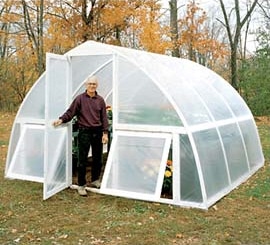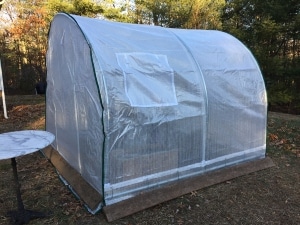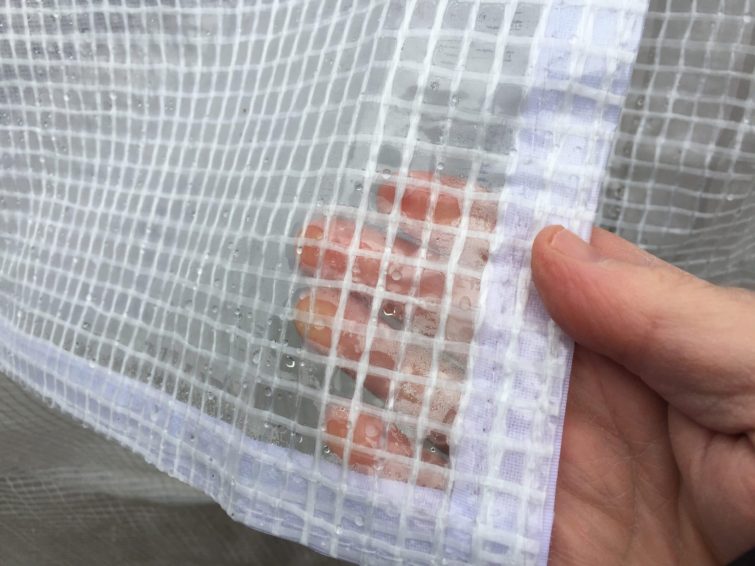Updated: November 26, 2020
Hoop house kits make it fast and easy to get a high tunnel in your backyard.
They give you a way to plant as much as six weeks earlier in spring and extend the season later into the fall — with no need to add artificial heat. In fact, if you live in a place where the winters don’t get very cold, you could possibly garden all year round.
So it’s no wonder a hoop house kit is an appealing idea to backyard growers.
It becomes even more appealing when you see that there are so many small hoop house kits available.
Let’s take a sec to get the legal words out of the way. This article may contain affiliate links. That means if you click and buy from my partners, I will make a tiny amount of money. This in no way affects my recommendations.
Let’s review the one I bought plus two other options.
Table of Contents
This is a long, detailed article. You can jump to where you want to be by clicking on the different sections below. To come back to this table of contents, just use the back button on your browser.

Protected culture
Interestingly enough, hoop house growing is so appealing that people have coined a new term: protected culture.
You already know about “agriculture” and “aquaculture.” Increasingly, weekend gardeners practice “permaculture.” Similarly, protected culture refers to a type of plant growing.
Protected culture means using season extending techniques, for example, cold frames, hoop house kits, polytunnels, high tunnels, greenhouses, etc. to grow plants in environments that are protected from the elements.
In addition, protected culture has great advantages for the backyard grower.
Maine farmer and author Eliot Coleman put it this way: “Low-cost tunnel greenhouses work so well that if the public were more familiar with them, I think every gardening family would have one.”
Certainly, gardening in a hoop house in the off season has its advantages:
- No bugs to bother you or eat your plants
- Fewer wild animals to dig up or chomp down on your vegetables
- Lower temperature means less watering
- Longer growing season means more and better results
So why are hoop houses still rare among backyard vegetable growers?
One of the main reasons is because building a structure that (1) looks decent, (2) won’t collapse in the snow or (3) won’t blow away in the wind is a daunting construction project (at least for some people).
Furthermore, assembling even an “easy-to-assemble” hoop house kit can still be beyond the skills of many gardeners.
Carpentry skills
So a truly easy-to-assemble hoop house kit is pretty appealing for many gardeners. Unfortunately, the kits that are available still seem to require at least some carpentry skills.
Many people report in the gardening forums that assembly was much more challenging than the supplier advertised. However, once they built the hoop house, most people were pleased with the results.
To help make it more easy for gardeners to find an inexpensive hoop house kit for their backyard, I’ve assembled some basic information about what’s available.
This guide is limited to hoop houses and not greenhouses because high poly tunnels (as hoop houses are also called) are inexpensive, easier to move and less time consuming to maintain.
Review Weatherguard Kit
The two main components in hoop house kits are the (1) frame and the (2) cover.
I’ve been using the Weatherguard hoop house kit (bought from Amazon) since 2016. Although the brand on Amazon and other stores is listed as Weatherguard, the company that manufacturers it is Jewett-Cameron Company.
Before I get into the specifics of this review, I want you to know that I had no difficulties assembling the Weatherguard. More specifically, it took me and another person only two hours to put together.
Still, Weatherguard could have made it easier with better directions. However, someone with more assembly experience probably wouldn’t have even looked at the directions.

For more information about the Weatherguard Hoop House by Jewett-Cameron, click here.
My hoop house kit’s frame
I’ve been very impressed with the frame that comes as part of this kit. It has held together quite nicely in spite of some very windy weather and heavy snow. During an extremely bad spring storm it came loose from the anchors and tumbled a couple hundred feet until it came to rest on some small trees.
Some of the hoops came apart, but there was no lasting damage to the frame or the cover — nothing that I couldn’t fix by re-assembling.
My hoop house kit’s cover
While Weatherguard made a great frame, the cover is another story.
After the first year, the door zipper pretty much stopped working. Plus, the screening for the back window ripped for no reason. (Window screening is important because that’s what keeps hornets from making nests inside the hoop house.)
After the second year, the cover ripped on the edge due to some heavy, wet snow, making the hoop house unusable.
In the third year, I ordered a new cover from Weatherguard. Right away, I could see that it was much better. The door zippers seemed stronger. The window screens and the plastic cover were reinforced throughout.
Above all, the cover was all one piece, making it much quicker to put on (and keep in place).
Now that I’ve had a couple of seasons with the new cover, I’m very impressed. More specifically, the zippers are working fine. The cover is functioning as it should. The frame is still holding up.
In short, when looking at new hoop house kits, the Weatherguard was a good investment if you take into account the new cover.
When I was shopping for new hoop house kits, there were two others that I considered. At the time, I liked the way Weatherguard made the door and windows. So I didn’t go with either of these.
Here are the details on these two high tunnel kits:
Gardman Small Poly-Tunnel

| Covering | Reinforced |
| Hoops | Tubular frame |
| Other | Zippered door |
| Shipping | Free with Prime |
| Not provided | Base panels |
| More info | Click here |
| Price | Click here |
Abba Patio Hoop House

For more information about the Abba Patio Hoop House, click here.
| Cover | Strong material |
| Hoops | Grey steel |
| Other | Zippered door Hardware |
| Shipping | Free with Prime |
| Not provided | Wood base |
| More info | Click here |
| Price | Click here |
Hoop house kit FAQ
The purpose of a hoop house is to allow gardeners to start growing as much as six weeks sooner in the year and extend the season as much as six weeks when the weather turns cold.
A high tunnel is the same thing as a hoop house. It’s a season extending device that protects vegetable plants and herbs against the elements. Market growers tend to call hoop houses high tunnels, while backyard growers tend to call them hoop houses. Generally, a high tunnel is on the larger side, while a hoop house is smaller.
A poly tunnel is a device like a hoop house or high tunnel. It covers plants with plastic to protect them from the elements. Unlike a high tunnel, the plastic can be suspended by hoops high off the ground or only a few feet off the ground.
Protected culture is when gardeners or farmers use techniques to protect plants from the elements. Protected culture techniques include hoop houses, high tunnels, low tunnels, row covers, cold frames, poly tunnels and more. Like agriculture, aquaculture, permaculture, etc., it’s a way to grow plants.
A well-constructed 20′ long x 10′ wide x 7′ high hoop house kit for your backyard will cost about $199. This is a worthwhile expense because a hoop house or high tunnel will allow you extend the growing season and protect your vegetables from the elements.
A hoop house or high tunnel is a type of greenhouse. Typically, greenhouses are made from heavy glass or Plexiglas and are more permanent. Small hoop houses, on the other hand, are made from metal or plastic hoops with a lightweight plastic cover. They cost less. The big advantage of a backyard hoop house over a greenhouse is two people can move it pretty easily.
A backyard hoop house or high tunnel is a structure made from hoop frames with a plastic covering. The structure allows warming sunlight to pass through, but prevents some of the heat from escaping. This increases the temperature inside and warms the soil so that plants can still grow when it starts to get cold outside. A hoop house also protects plants from wind and damaging rain, making for a more hospitable environment for vegetables.
Where it’s cold in the winter, backyard gardeners use hoop houses to extend the growing season and otherwise protect vegetable plants from the elements. Common vegetables that really benefit from hoop house growing include tomatoes, early and late season salad greens, early season beets, cucumbers and more.
Polytunnels or hoop houses are a type of greenhouse. Both benefit from trapping the sun’s heat. Both also can sometimes benefit from added heat. On the one hand, greenhouses typically are made from materials that insulate better, so they sometimes will need less artificial heat than hoop houses. On the other hand, polytunnels are made from less expensive, lighter materials. Because of this, you can usually move them from one location to another much more easily.
I find that tomatoes, cucumbers, beets and salad greens of all types really benefit from hoop house growing. But you have to use different strategies for different plants. Tomatoes, for example, should be started from seed in containers in a warm environment. They won’t be able to tolerate cold nights in an unheated high tunnel. As soon as the second leaves start, you can move them into the high tunnel during the day when the temperature is warm enough. Then transplant them into the ground in the hoop house when the nights are warm enough.
There are a number of methods that people use to heat hoop houses when it’s cold outside. Each has varying degrees of success. Some attach a shed to a hoop house and put a properly installed wood stove in the shed. The wood stove heats the air in the growing area. Some use the heat from decomposing compost. Some heat hot water and run warming tubes under the soil. Some place terra cotta pots over candles to create little heaters. Probably the easiest but most expensive method is to use electric heat.
One interesting method for insulating a hoop house or high tunnel is to add a layer of bubble wrap under the cover. The sun will store heat in the air bubbles, making for effective, yet inexpensive insulation. Another way to insulate is to use two layers of plastic with a fan blowing air in between.
Some growers use a water tank in a hoop house to store heat from daytime sun. The heat stored in the thermal mass of the water is naturally released during the night, keeping the plants warm. Storing heat in thermal mass doesn’t have to use water. Any thermal mass that will cost effectively store heat will act as a heat battery.
A polytunnel is made of two main components: the frame and the cover. The frame in a backyard hoop house kit will last many years. On the other hand, the cover will typically last three or four seasons in areas that see a lot of snow. Some of the new, reinforced covers will last longer.
In areas where temperatures consistently drop below freezing, you can’t grow vegetables in an unheated hoop house. The night time temperatures will freeze even the hardiest vegetables. You can harvest carrots in winter. In fact, they’ll even taste better, but they aren’t actually growing. Some hardy salad greens (e.g., spinach) will take a few nights of sub-freezing temperatures and bounce back.
Yes a hoop house made from a hoop house kit will survive winter snow. It will mostly slide off. You should, however, remove as much snow as soon as possible. I’ve found, however, that it helps if you have reinforcement where there’s a lot of space between the hoops. One way to do this is to run electrical wire horizontally across the hoops and add pool noodles over the wire. Another way to provide extra support is to prop wood boards running from the ground to the plastic. This will work as a backstop and add extra support to areas where there is a lot of space between the hoop.
You don’t need artificial lights in a hoop house in most areas. One of the big benefits of starting seedlings in a hoop house is that, during the day, it’s warm enough even when it’s cold outside. This allows you to take advantage of the sun’s powerful light.
You can easily move a hoop house that is made from a hoop house kit. Typically, two people can move it in a few minutes. This comes in handy when you are having some difficulties with the soil inside the hoop house. You can just move it instead of replacing the soil.
Many vegetable plants grow better in a highly humid environment. A hoop house or high tunnel captures both heat and humidity. This makes for an improved growing environment for tomatoes and other heat and humidity loving plants.
You need to harden off plants that you have started in a greenhouse. Why? Because hardening off allows your plants to adjust to the new amounts of wind, light and cold in the great outdoors. But plants will need less adjustment when coming from an unheated hoop house. This is because the amount of light is close to the amount plants would get outdoors. The temperature also is about the same. However. there usually is more wind. So you should still harden off your plants. But you can be a little more aggressive in how quickly you transplant them.
Related articles you might enjoy:
Suburban Hobby Farmer is a participant in the Amazon Services LLC Associates Program, an affiliate advertising program designed to provide a means for sites to earn advertising fees by advertising and linking to amazon.com.
